Butterflies are not just delicate and beautiful creatures; they are also fascinating indicators of the diversity and health of our ecosystems. With over 17,500 species worldwide, butterflies come in a stunning array of colors, patterns, and sizes. However, not all butterfly species are equally common or easy to spot.
In this article, we will introduce you to 7 rare butterfly species that are truly extraordinary. These unique and exotic butterflies are not only captivating to observe but also face various conservation challenges due to habitat loss, climate change, and human activities.
Key Takeaways:
- There are over 17,500 species of butterflies worldwide.
- Rare butterfly species are under threat due to habitat loss and human activities.
- Conservation efforts are essential for protecting rare butterfly species and their habitats.
- Observing and learning about rare butterflies can help raise awareness of their conservation needs.
- Appreciating the beauty and importance of rare butterflies contributes to the preservation of biodiversity.
Lange’s Metalmark Butterfly: A Fragile Beauty
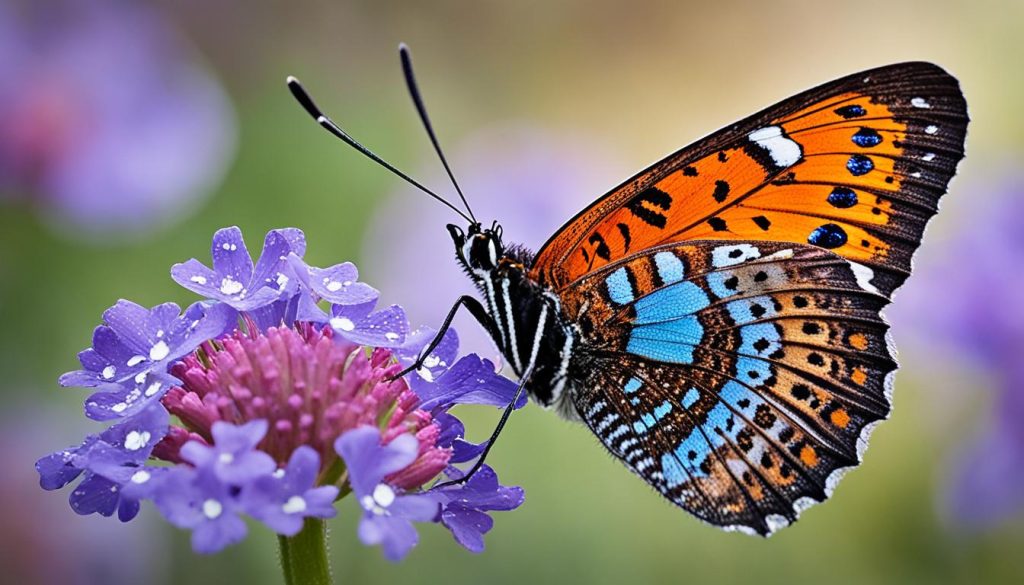
The Lange’s Metalmark butterfly, scientifically known as Apodemia Mormo Langei, is an endangered butterfly species and one of the rarest butterflies in the world. With only a few hundred individuals remaining, this delicate butterfly is a true gem of nature.
Endemic to the Antioch Dunes along the Sacramento River in California, the Lange’s Metalmark butterfly inhabits sandy areas and depends exclusively on buckwheat leaves as its food source. However, the butterfly’s habitat has been severely impacted by human settlement, leading to habitat loss and the destruction of its food source.
To protect this endangered species, the Antioch Dunes National Wildlife Refuge was established. This refuge plays a critical role in preserving the Lange’s Metalmark butterfly’s habitat and providing a safe environment for its survival.
| Common Name | Scientific Name | Status | Habitat |
|---|---|---|---|
| Lange’s Metalmark butterfly | Apodemia Mormo Langei | Endangered | Sandy areas of the Antioch Dunes |
Conservation efforts are crucial to ensuring the survival of the Lange’s Metalmark butterfly. By protecting its habitat and implementing measures to restore and sustain the buckwheat population, we can give this fragile beauty a chance to thrive for future generations.
Luzon Peacock Swallowtail: A Colorful Rarity in the Philippines
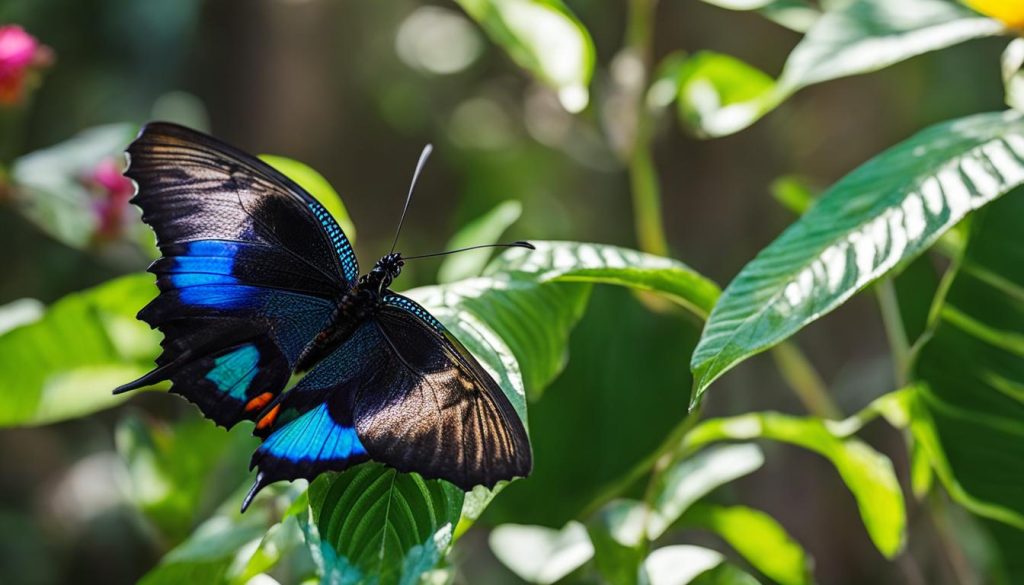
The Luzon Peacock Swallowtail, scientifically known as Papilio Chikae, is a highly endangered butterfly species that was discovered on the island of Luzon in the Philippines back in 1965. With its vibrant colors and large wingspan, this butterfly is truly a sight to behold.
However, the Luzon Peacock Swallowtail faces significant challenges to its survival. Its range is limited and threatened, and habitat loss further exacerbates the situation. The destruction of its delicate ecosystem puts this rare butterfly species at risk of extinction.
To ensure the protection of the Luzon Peacock Swallowtail and its ecosystem, dedicated conservation efforts are in place. These initiatives aim to preserve the remaining populations, restore habitat, and raise awareness about the importance of conserving this unique and endangered butterfly species.
Conservation Efforts
To safeguard the Luzon Peacock Swallowtail, various conservation strategies have been implemented:
- Protecting natural habitats: Efforts are being made to establish protected areas and reserves that specifically cater to the needs of this endangered species.
- Restoring degraded habitats: Restoration projects focus on rehabilitating damaged habitats, allowing the Luzon Peacock Swallowtail to thrive once again.
- Educating communities: Conservation organizations and local communities collaborate to raise awareness about the importance of protecting this rare butterfly species and its habitat.
- Research and monitoring: Continuous research and monitoring initiatives enable scientists to gather valuable data to inform conservation efforts and track population trends.
By implementing these conservation measures, there is hope for the preservation of the Luzon Peacock Swallowtail and the restoration of its delicate ecosystem. A collective effort is required to ensure the survival of this colorful rarity in the Philippines.
Notable Facts about the Luzon Peacock Swallowtail
The Luzon Peacock Swallowtail is truly a gem of the butterfly world, with its striking colors and graceful flight. Its endangered status underscores the urgency of conservation efforts to protect this beautiful rarity.”
- The Luzon Peacock Swallowtail is primarily found in the forests of Luzon Island in the Philippines.
- It has a wingspan of approximately 14 centimeters, making it one of the larger butterfly species.
- Male butterflies exhibit bold black and iridescent blue wings, while females have a more subdued coloration with a touch of orange.
- The caterpillars feed on specific host plants, including members of the citrus family, which are crucial for their development.
- Once prevalent throughout Luzon, the Luzon Peacock Swallowtail’s population has significantly declined due to habitat loss.
Blue Morpho Butterfly: A Jewel of the Rainforest
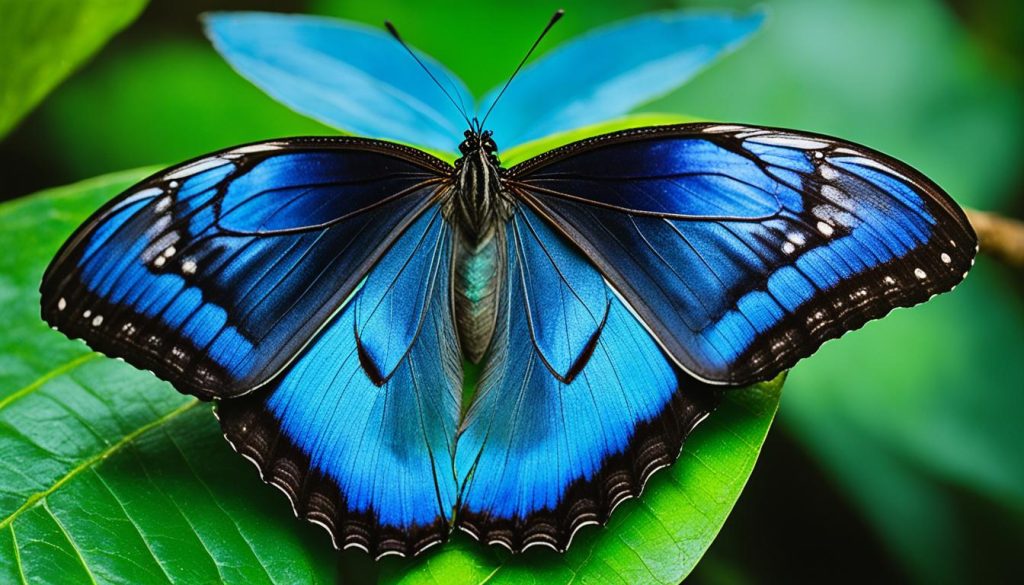
The Blue Morpho butterfly, scientifically known as Menelaus blue morpho, is a true gem of the rainforest. This magnificent butterfly is native to the tropical regions of Latin America, where it graces the lush greenery with its vibrant blue wings. Its scientific name, Menelaus blue morpho, pays homage to the Greek mythological figure Menelaus, who was known for his splendor.
The Blue Morpho butterfly has a relatively short lifespan of about 115 days, during which it undergoes a miraculous transformation from a caterpillar to an exquisite butterfly. These beautiful creatures spend their time in the rainforest primarily focused on finding and consuming the fruit they need to survive. As they feast on fallen fruits, their wings shimmer and reflect the sunlight, creating a dazzling spectacle.
However, the Blue Morpho butterfly faces significant challenges in its natural habitat. Habitat loss due to deforestation is one of the major threats to its population. The destruction of rainforest ecosystems deprives these butterflies of their breeding and feeding grounds, impacting their ability to reproduce and survive.
Furthermore, the allure of the Blue Morpho butterfly has also made it a target for butterfly collectors. These collectors seek to capture these magnificent creatures for their personal collections or to sell them on the black market. Unfortunately, this high demand exacerbates the decline of the Blue Morpho butterfly population.
“The Blue Morpho butterfly is a living masterpiece of nature, its iridescent blue wings reflecting the true splendor of the rainforest. It is our responsibility to protect this jewel and ensure its survival for future generations to admire.”
To combat these threats, conservation efforts are essential. Organizations and researchers are working tirelessly to preserve the rainforest habitats of the Blue Morpho butterfly and raise awareness about the importance of its conservation. By implementing sustainable practices and advocating for stricter regulations against habitat destruction and butterfly collectors, we can strive to safeguard the future of this remarkable species.
The Blue Morpho Butterfly in a Nutshell:
- Scientific Name: Menelaus blue morpho
- Native to: Tropical regions of Latin America
- Short Lifespan: Approximately 115 days
- Main Focus: Finding and consuming fruit for survival
- Threats: Habitat loss and butterfly collectors
- Conservation Efforts: Protecting rainforest habitats and raising awareness
Queen Alexandra’s Birdwing: The Largest Butterfly in the World
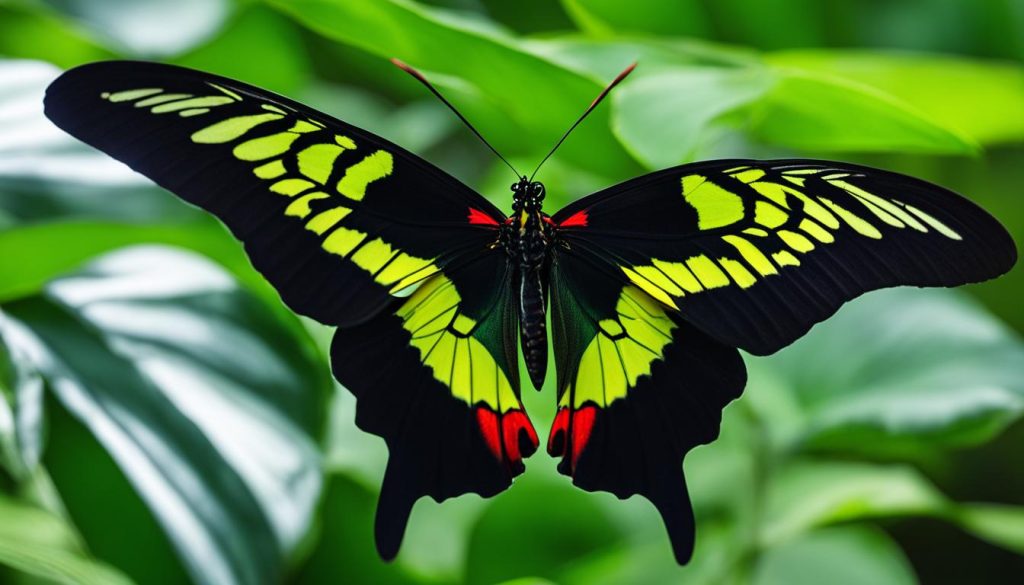
The Queen Alexandra’s Birdwing butterfly, scientifically known as Ornithoptera Alexandrae, is truly a remarkable creature. With a wingspan of about 11 inches, it proudly holds the title for being the largest butterfly species in the world. Found exclusively in the forests of Oro Province in eastern Papua New Guinea, this butterfly is a true treasure of nature.
Unfortunately, the Queen Alexandra’s Birdwing is facing a grave threat – habitat destruction. As human activities continue to encroach upon the butterfly’s natural habitat, the delicate balance of the ecosystem is disturbed, putting this majestic species at risk.
Habitat destruction refers to the degradation, fragmentation, and outright loss of a natural habitat. It happens as a result of various factors such as deforestation, urbanization, and the expansion of agricultural activities. In the case of the Queen Alexandra’s Birdwing, deforestation poses a significant danger as the clearing of forests for logging, agriculture, and infrastructure development leaves the butterfly with limited areas to thrive.
To combat the threat of habitat destruction and ensure the survival of the Queen Alexandra’s Birdwing, conservation efforts are vital. These efforts involve a multi-faceted approach, including:
- Establishing protected areas and reserves to safeguard the butterfly’s habitat
- Implementing sustainable logging practices to minimize deforestation
- Promoting awareness and education about the importance of preserving biodiversity
- Supporting local communities in sustainable livelihoods that do not harm the butterfly’s habitat
By taking these measures, we can protect the Queen Alexandra’s Birdwing and preserve the intricate web of life in Papua New Guinea’s forests. Conservation organizations, governments, and individuals all play a crucial role in ensuring the survival of this magnificent butterfly.
Conservation Status of the Queen Alexandra’s Birdwing Butterfly
“The Queen Alexandra’s Birdwing butterfly is listed as endangered on the International Union for Conservation of Nature (IUCN) Red List. This designation reflects the high level of threat it faces due to habitat loss. Urgent action is needed to protect and conserve this iconic species.”
With its vibrant colors and impressive size, the Queen Alexandra’s Birdwing butterfly is not just a beautiful insect – it represents the delicate balance of nature and the interconnectedness of ecosystems. Preserving its habitat goes beyond protecting a single species; it ensures the health and well-being of countless other organisms that rely on the same environment.
| Scientific Name | Ornithoptera Alexandrae |
|---|---|
| Common Name | Queen Alexandra’s Birdwing |
| Location | Oro Province, Papua New Guinea |
| Wingspan | Approximately 11 inches |
| Conservation Status | Endangered |
Kaiser-i-Hind Butterfly: A Speedy High-Flyer in the Himalayas
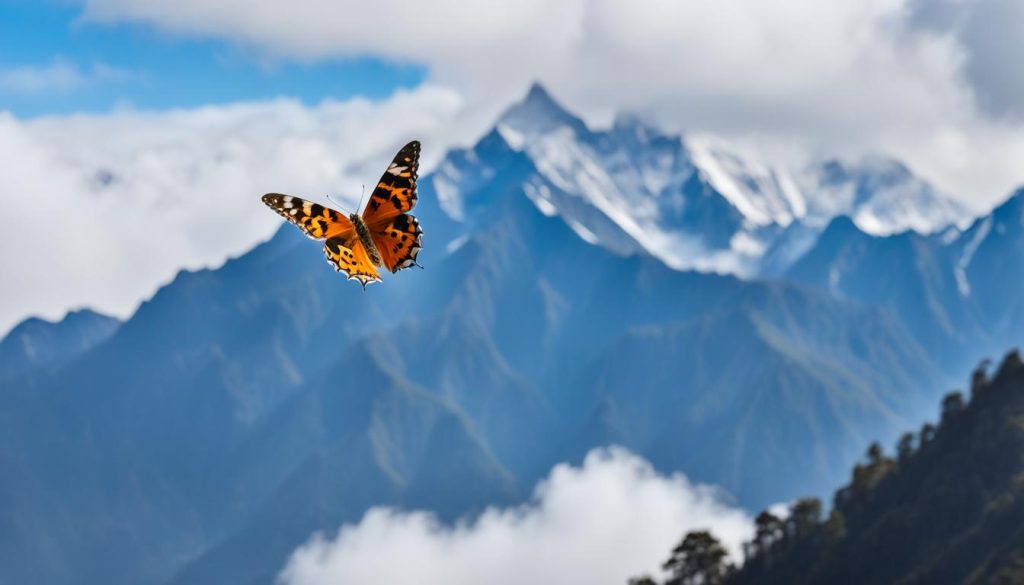
The Kaiser-i-Hind butterfly, also known as the Golden Kaiser-i-Hind, is a rare and endangered species found in the Eastern Himalayas. This magnificent butterfly, scientifically known as Teinopalpus imperialis, showcases remarkable speed and high-flying abilities, captivating the hearts of nature enthusiasts.
However, the Kaiser-i-Hind butterfly is facing a decline in population due to habitat loss and illegal wildlife trade. As human activities encroach upon its natural habitat in the Himalayan Mountains, this endangered species struggles to survive.
Conservation efforts are currently underway to protect the Kaiser-i-Hind butterfly and its mountainous ecosystem. Environmental organizations and local communities are working together to raise awareness about the importance of preserving this unique species and its fragile habitat.
“The Kaiser-i-Hind butterfly is truly a marvel to behold. Its swift and graceful flight across the breathtaking landscapes of the Himalayas is a testament to the beauty and resilience found in the natural world.”
To shed light on the urgency of conservation, here is a table illustrating the current population status of the Kaiser-i-Hind butterfly:
| Population Status | Number of Individuals |
|---|---|
| Endangered | Less than 1,000 |
As the table demonstrates, the population of the Kaiser-i-Hind butterfly is alarmingly low, highlighting the need for immediate action to protect this endangered species.
The conservation efforts for the Kaiser-i-Hind butterfly involve initiatives such as habitat restoration, establishment of protected areas, and community involvement in sustainable practices. These efforts aim to safeguard the butterfly’s habitat and mitigate the threats it faces.
By raising awareness and working collaboratively, we can ensure the survival of the Kaiser-i-Hind butterfly and preserve the Himalayan Mountains as a sanctuary for this extraordinary species.
Leona’s Little Blue Butterfly: A Tiny Treasure in Oregon
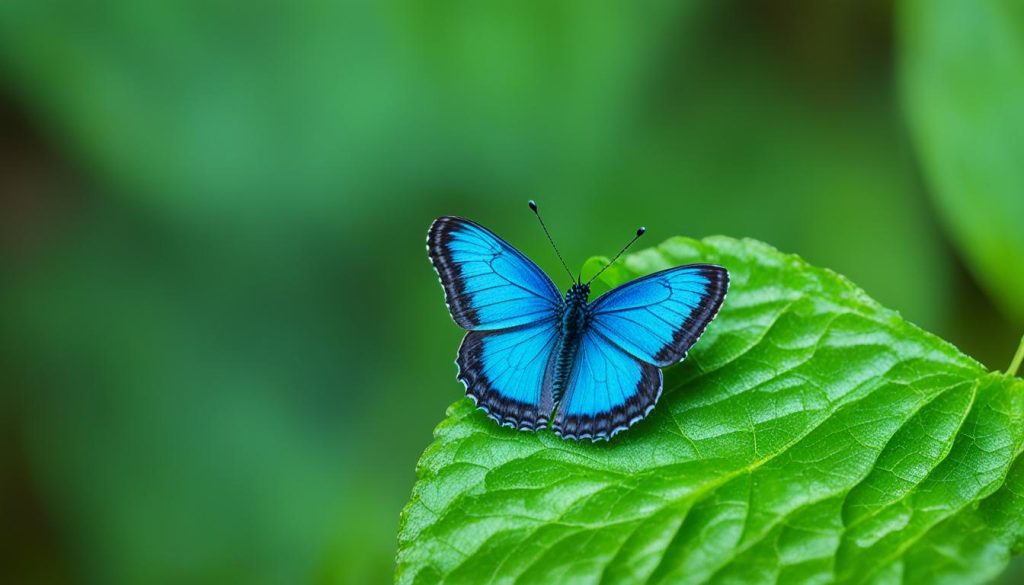
The Leona’s Little Blue butterfly, scientifically known as Philotiella leona, is a small and rare butterfly species that was only discovered in 1991. With its delicate wings and vibrant blue color, this butterfly is truly a sight to behold. However, its small population and limited range make it an endangered species in need of conservation efforts.
This exquisite butterfly can only be found within a six square mile area in Klamath County, Oregon. It relies on lodgepole clearings as its habitat and feeds exclusively on buckwheat nectar. Any disruption to its habitat or food source puts the survival of this unique butterfly at risk.
Conservation organizations and researchers are working tirelessly to protect the habitat of Leona’s Little Blue butterfly and ensure its continued survival. Through habitat preservation and restoration efforts, as well as educational initiatives, they aim to raise awareness about the importance of protecting endangered butterfly species.
By safeguarding the delicate balance of ecosystems in Klamath County, we can help preserve not only Leona’s Little Blue butterfly but also countless other species that depend on these habitats for survival. It is our responsibility to act as stewards of nature and protect these tiny treasures for future generations to enjoy.
Conservation Efforts for Leona’s Little Blue Butterfly
Conservation efforts for Leona’s Little Blue butterfly include:
- Preserving and restoring lodgepole clearings, the butterfly’s habitat.
- Engaging in research and monitoring to better understand the species’ behavior and population dynamics.
- Collaborating with local communities and stakeholders to raise awareness about the butterfly’s conservation needs.
- Implementing measures to combat habitat destruction and promote sustainable development practices in Klamath County.
Island Marble Butterfly: A Rediscovered Beauty in Washington State
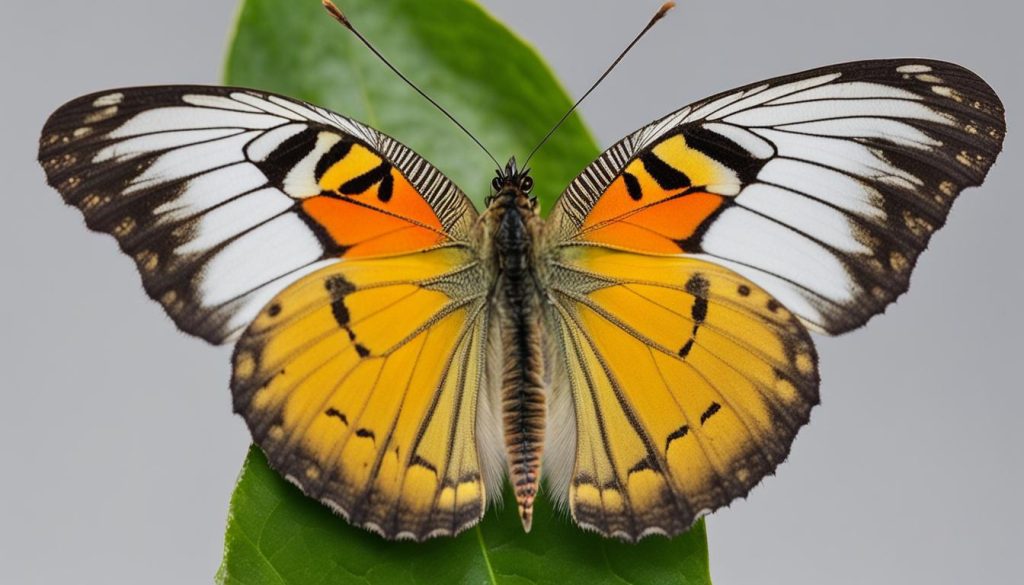
The Island Marble butterfly, scientifically known as Euchloe ausonides insulana, is an endangered species that was thought to be extinct since 1908. However, in 1998, this rare butterfly was rediscovered, bringing hope for its conservation and survival.
This exquisite butterfly is found exclusively in the stunning San Juan Islands in Washington State. The unique combination of climate and vegetation in the San Juan Islands creates the perfect habitat for the Island Marble butterfly to thrive.
Unfortunately, the Island Marble butterfly faces numerous challenges that have pushed it to the brink of extinction. Habitat loss due to urban development and agriculture has significantly reduced the available space for this delicate butterfly species. Additionally, the Island Marble butterfly’s isolated populations and limited range further exacerbate the threats it faces.
Conservation efforts are now underway to protect and restore the Island Marble butterfly population in the San Juan Islands. These efforts involve habitat restoration, conservation education, and research initiatives to better understand the butterfly’s behavior and needs.
By raising awareness about the Island Marble butterfly’s plight and taking concerted conservation actions, we can secure the future of this rediscovered beauty. Preserving the unique ecosystems of the San Juan Islands is not only essential for the survival of the Island Marble butterfly but also for the overall health and biodiversity of our planet.
The Struggles of an Endangered Butterfly
“The Island Marble butterfly’s endangered status highlights the urgent need for habitat protection and conservation efforts,” says Dr. Jane Miller, a butterfly expert and conservationist. “As human activities continue to encroach upon its fragile ecosystem, immediate action is required to ensure the survival of this rare and beautiful creature.”
The Island Marble butterfly’s unique life cycle and specific habitat requirements further contribute to its vulnerability. This butterfly relies on a specific plant species as a host for its larval stage and nectar source for its adult stage. Any disruption to this delicate balance can have severe consequences for the butterfly’s survival.
The collaborative efforts of biologists, government agencies, and local communities are crucial in saving the Island Marble butterfly from extinction. By protecting its habitat, implementing conservation strategies, and promoting sustainable land use practices, we can secure a bright future for this extraordinary species.
The Importance of the Island Marble Butterfly
Preserving the Island Marble butterfly is not only about saving a single species; it is about safeguarding ecosystems and biodiversity as a whole. Butterflies, including the Island Marble butterfly, play vital roles as pollinators and indicators of environmental health.
“The Island Marble butterfly’s presence or absence can act as a barometer of the overall health and balance of the San Juan Islands’ ecosystem,” explains Dr. Sarah Peterson, an ecologist and advocate for endangered species conservation. “By protecting the Island Marble butterfly, we are also protecting the intricate web of life that relies on healthy ecosystems.”
The Island Marble butterfly serves as a symbol of resilience and hope. Its rediscovery reminds us that even in the face of apparent extinction, nature can still surprise and inspire us. By working together to safeguard the Island Marble butterfly, we are taking a vital step towards preserving the rich biodiversity of our planet.
Conclusion
Rare butterfly sightings are not only a mesmerizing experience but also serve as important indicators of the health of ecosystems. However, these beautiful creatures face numerous threats, including climate change, habitat destruction, and human activities.
Fortunately, dedicated efforts are being made by conservation organizations and researchers to protect these rare butterflies and their habitats. Through extensive research, monitoring, and conservation strategies, valuable information is gathered to better understand the needs and challenges faced by these species.
By raising awareness about the importance of rare butterfly conservation and implementing effective strategies, we can help preserve these unique and delicate creatures for future generations to enjoy. It is crucial for all stakeholders, from governments to individuals, to play an active role in safeguarding rare butterfly habitats and supporting conservation efforts.
Together, we can make a difference and ensure that rare butterfly sightings continue to inspire awe and admiration for many years to come.
FAQ
What are some rare butterfly species that exist?
Some rare butterfly species include the Lange’s Metalmark butterfly, Luzon Peacock Swallowtail, Blue Morpho butterfly, Queen Alexandra’s Birdwing butterfly, Kaiser-i-Hind butterfly, Leona’s Little Blue butterfly, and Island Marble butterfly.
Where can the Lange’s Metalmark butterfly be found?
The Lange’s Metalmark butterfly can be found in the sandy areas of the Antioch Dunes along the Sacramento River in California.
What is the habitat of the Luzon Peacock Swallowtail?
The Luzon Peacock Swallowtail is found on the island of Luzon in the Philippines.
What is the native range of the Blue Morpho butterfly?
The Blue Morpho butterfly is native to the tropical regions of Latin America.
Where is the Queen Alexandra’s Birdwing butterfly found?
The Queen Alexandra’s Birdwing butterfly is found in the forests of Oro Province in eastern Papua New Guinea.
Where can the Kaiser-i-Hind butterfly be found?
The Kaiser-i-Hind butterfly is found in the Eastern Himalayas.
What is the range of the Leona’s Little Blue butterfly?
The Leona’s Little Blue butterfly has a limited range in a six square mile area in Klamath County, Oregon.
What is the habitat of the Island Marble butterfly?
The Island Marble butterfly is found only in the San Juan Islands in Washington State.
Why are these rare butterflies endangered?
These rare butterflies are endangered due to factors such as habitat loss, climate change, and human activities.
What conservation efforts are being made to protect these rare butterflies?
Conservation efforts are being made, including establishing protected habitats and raising awareness about the importance of preserving these unique butterfly species.






